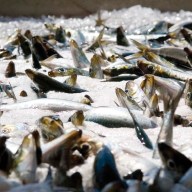We’re sitting on two bamboo sticks in the small wooden boat that’s taking us to Apo, an island in the southern part of the Philippines that’s home to one of the best dive sites in the world — a marine reserve with a protected reef full of colourful clownfish.
Apo is just one of the 7,017 islands in the Filipino archipelago. It has exactly two resorts and a village of 400 inhabitants. As we drag our backpacks from the boat, all we hear are waves lapping at the beach and divers talking about their last trip under the sea.
Liberty’s, where we’ll be staying, is located in a white-and-green-stone building tucked behind a row of palm trees, and is connected to Paul’s Diving, the only diving school on the island. The eccentric Englishman who runs the school knows which diving spots offer the best chance of viewing certain species. Every night, he talks to visitors to find out what they’d like to see on the next day’s dive.
Even novice divers armed with just a snorkel and diving mask can get a good look at the colourful and vivacious underwater world. Alternatively, the quiet beaches on Apo Island are ideal for a day of loafing about with a good read. (The Philippines doesn’t get as many tourists as its neighbour, Thailand, so it’s easier in general to find wide sandy beaches that aren’t packed with pasty sun-seekers.)
If you pay a bit extra to get a room with a balcony, you’ll have an prime view of a brilliant yellow, orange and red sunset exploding into the deep blue sea. And because electricity shuts down on Apo Island at 9 p.m., views of the night sky are spectacular. (However, unless you want to set with the sun, we recommend bringing a good flashlight and lots of batteries.)
The widespread use of English makes travelling around the Filipino islands easy. All schedules are in English, which makes the country a great destination for island hopping.
Finally, it’s relatively cheap to venture around the Philippines. The cost of our two-week trip for two adults ran to about $1,705 including food, accommodation and diving. We stayed at mid-range hotels in rooms with private bathrooms and took cabs rather than buses.
The only drawback we found is that when island-hopping, hot showers can be few and far between on the islands. Then again, it’s on the islands that you really get to interact with the locals, who may even invite you to join in their favourite pastime — “videoke,” or karaoke with video subtitles.
















